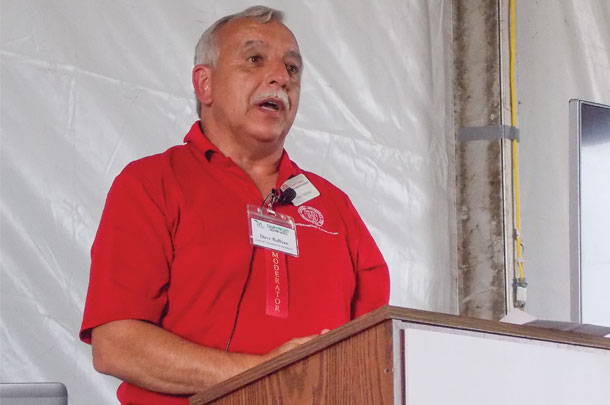It’s an elite club, but there is no membership list. According to Cornell Cooperative Extension dairy specialist Dave Balbian, the 7-pound “club” isn’t really a club at all.
Rather, it is a benchmark for dairies to strive for in improving the fat and protein components in their herds’ milk.
“It’s like being valedictorian of your graduating class,” Balbian says. “Not everybody will do it, but those who do are working hard for it every single day.”
The 7-pound club, which has become increasingly popular in New York since a 2015 article co-written by Balbian and Thomas Overton, professor of dairy management at Cornell University, refers to the few elite dairies that boast more than 7 pounds per day of combined milkfat and true protein per cow in the herd.
While milkfat and protein yields are often correlated with higher general milk yield, research conducted on the topic has shown both high milk yield and high component percentages are necessary contributors to meeting a goal of 7 or more pounds of fat and protein per cow per day.
As a 2015 article [published in Cornell University’s The Manager newsletter] states: “Milk yield is highly dependent upon excellent management in all facets of the dairy. This includes forage quality, transition cow management, grouping management and cow flow, nutritional management, including both ration formulation and feed management, reproduction, udder health and calf and heifer management.”
Balbian estimates that, on average, a half-dozen New York dairies are at or very near the benchmark in any given month.
“There really is no formal ‘club,’ but we do try to be a resource to those who are close to making it and to those who continually are reaching this impressive goal on their dairies,” Balbian says.
The high components levels are often correlated with higher levels of net milk income per cow per day compared to peers producing less milkfat and protein per cow.
“This is a tremendous accomplishment,” Balbian says. “High milk yield isn’t enough to achieve it – you really do need the high component percentages to reach a higher level of productivity on the farm.”
Simply stated, there’s more to the equation than simply making a lot of milk.
A wide array of management decisions, from attention paid to forage quality to decisions in calf and heifer management, factor into a farm’s total fat and protein levels.
Even several non-nutritional factors have been shown to impact milk yield and components content – namely, genetics, breed and environmental factors ranging from season of the year to a cow’s individual lactation schedule.
“Of course, yield is important,” Balbian says. “But the dairies that are consistently hitting the 6- and 7-pound mark (in milkfat and protein) are at that level because of the choices they make every day on the farm.”
To those interested in improving the components numbers in their own herds, Balbian suggests building a team on the dairy.
“In addition to extension, there are many people who should be playing a key role on the farm to achieve goals like this,” he says. “The farms that consistently hit this mark are working with their nutritionists; they’re keeping a close eye on calves and dry cows. Nothing is getting overlooked. They recognize how much the details matter.” ![]()
In the quest for components, consistency is key
There is no silver bullet. This was the general consensus of dairy farmers and industry professionals who participated in an Aug. 10 discussion panel, “The 7-Pound Club” at Empire Farm Days in Seneca Falls, New York.
The club, an unofficial group of dairy farmers who consistently ship an average of 7 pounds of milkfat and protein per cow per day, was first conceived after an article by Cornell University professor Thomas R. Overton and Cooperative Extension dairy specialist Dave Balbian laid the groundwork for farms to reach such achievements.

“This is a tremendous accomplishment and requires high milk yield and high milk component percentages to reach this level of productivity,” said Overton and Balbian in the 2015 article. “They achieve very high levels of net milk income per cow per day compared to their peers.”
For the producers who have since adopted the techniques laid out in the article and begun personalizing plans for their own herds, the process is far from effortless.
“People come to me all the time asking what I do to keep [components high],” dairy producer Jerry Hull said in his presentation. “I say there is no one thing any of us can do except go to the barn every day and pay attention to detail. There is no silver bullet.”
Hull is a native of Leicester, New York, and currently operates Thornapple Farm, a 900-cow dairy. Working alongside his wife and children, he has built the herd and facilities from the ground up since re-entering the dairy business several decades ago.
Today, the herd at Thornapple Farm joins the ranks of what Balbian describes as New York’s “elite” dairy herds – but not without a fair amount of work.
Hull was one of three dairy farmers to speak during the panel discussion, which also included industry professionals who shared additional insight on the topic of maintaining components through proper nutrition and capitalizing on their worth in the marketplace.
Those who shared the stage that day agreed there is no simple answer to the question, “What do you do to achieve 7 pounds?” In one way or another, every facet of every activity on the farm can be translated to quality levels in milkfat and protein present in the herd.
“Truly, it starts with your employees,” Hull said. “We train them properly and treat them with respect so they will treat the cows well.”
From there, things only get more involved.
Matt Hanehan of Hanehan Family Dairy in Mt. Upton, New York, began dairying with his brother, Kurt, in 2006. Today, they milk 840 cows and consistently produce between 6.8 and 7 pounds of milkfat and protein per cow per day for the past year.
“Consistency is key,” Hanehan said. “From genetics to our breeding program to cow comfort, we monitor everything we do pretty carefully.”
On Hanehan Family Dairy, high components numbers begin with breeding decisions. They primarily use genomic bulls selected for feet and legs, mammary system and somatic cell score as well as strength in fat and protein.
According to Hanehan, cow comfort is also “hugely important” to their goal of maintaining a presence in the 7-pound club.
“We never, ever accept ‘good enough’,” Hanehan said. “We can always do better.”
Similar in attitude, brothers Marc and Frank Albano of Albano Farms in Stamford, New York, joined the ranks of the 7-pound club in February 2017.
While they do not hit the mark every month, some improvements in the works for the farm may be the ticket to securing a more permanent position in the club.
Until then, careful planning and consistent preparation on their 1,600-acre property helps them bridge the gap.
“To get where we are, we leaned on a lot of people for help and for information,” Frank Albano said. “There’s just no way to know everything you’d have to know in order to do everything just right.”
The true interest in value-added milk with higher component percentages is the way it factors in to the bottom line.
Bruce Dehm of Dehm Associates, a farm and dairy business consulting firm, contributed information on component pricing as well as planning and budgeting for those interested in reaching the 7-pound milestone.
“We have no control on component prices, only on the amount of components,” Dehm said in a discussion on the variabilities surrounding milk price throughout the region.
The importance of a team approach is echoed by Balbian, who encourages farmers to consult their nutritionist, those working on calf and heifer-raising programs and others in key areas of the farm.
“We, as extension, are here as a resource to these producers who are working to achieve specific goals,” Balbian said. “There are many others these farmers are working with to build and continually adjust a plan that will work best for their herd.”
One such individual is often a nutritionist. Jay Giesy is a senior dairy specialist for Cargill Feed and Nutrition with 17 years of experience.

His work with farm nutritionists in New York and New England has granted him the opportunity to see firsthand what the highest-achieving farms are accomplishing and in what way.
“What’s important to remember is: Successful farms don’t always do things the exact same way,” Giesy said. “But there are definitely common themes. If you do things well, day in and day out, the cows will pay you back for that. If you take a couple of days off ... they’ll remember.” ![]()
PHOTO 1: New York state dairy farmers join industry professionals in an Aug. 10 panel discussion titled, “Is your farm a member of the 7-Pound Club?” during Empire Farm Days in Seneca Falls, New York.
PHOTO 2: Cornell Cooperative Extension dairy specialist Dave Balbian introduces panel members to a crowd during an Aug. 10 discussion during Empire Farm Days in Seneca Falls, New York. Balbian was a leading influencer on the inception of the unofficial “7-pound club” and works with farms to achieve higher components levels in their milk.
PHOTO 3: Jay Giesy of Cargill Animal Nutrition shares his experiences working with nutritionists and members of the “7-pound club.” Photos by Callie Curley.
Callie Curley is a communications student at Penn State University.





